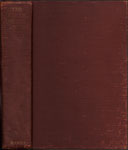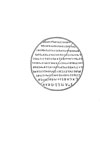James Branch Cabell : An Illustrated Bibliography
THE CREAM OF THE JEST: A Comedy of Evasions
Hall Code |
Description |
CoJ-A9 (K) |
Ninth Printing 1930 |
COMPILATION
Full Title:
Title page recto: [in italic] THE | CREAM | OF | THE JEST | [rule] |A Comedy of Evasions | [rule] | BY | JAMES BRANCH CABELL | WITH AN INTRODUCTION BY | HAROLD WARD | [in italic] " Le pays où je voulais aller, tu m'y as mené | en songe, celte nuit, et tu étais belle . . . | ah! que tu étais belle! . . . Mais, comme | je n'ai aimé que ton ombre, tu me dispen- | seras, chère tête, de remercier ta réalité." | NEW YORK | ROBERT M. McBRIDE & COMPANY | 1930 (see image above).
Title page verso: Copyright, 1917, by | JAMES BRANCH CABELL | [rule] | [in italic] Printed in the | United States of America | Ninth Printing, December, 1930 | [rule] | Published September, 1917 (see image above).
Publication:
New York: Robert M. McBride & Co., December, 1930
Collation:
Crown octavo [19.7 cm. (7¾ in.) x 13.7 cm. (5⅜ in.)]; Pp. xvi + 250 + 3 blank leaves not counted in pagination. (i) half-title; (ii) BOOKS by MR. CABELL; (iii) blank; (iv) frontispiece; (v) title page; (vi) publication data; (vii) dedication (verso blank); ix-xii Introduction, by Harold Ward; (xiii)-(xv) Contents (verso blank); (1) fly-title (verso blank); 3-250 text, followed by 3 blank leaves not counted in pagination. Pages (1), (33), (93), (127), (173), and (221) are fly-titles. Pages (iii), (viii), (xvi), (2), (34), (92), (94), (126), (128), (174), and (222) are blank.
Binding:
Kalki binding: brick red cloth with gilt lettering and decorations on spine and front cover; top edge trimmed, else untrimmed. Spine: THE | CREAM | OF THE | JEST | [rule] | CABELL | McBRIDE. Front cover: [Kalki device in lower right corner] (see image above).
Frontispiece:
The Sigil of Scotia, a drawing by James Branch Cabell (see image above).
Also see the discussion of the Sigil of Scotia on the index page for The Cream of the Jest.
Dedication:
TO | LOUISA NELSON | [in italic] "At me ab amore tuo diducet | nulla senectus." (see image above).
Mrs. Louisa Nelson was Cabell's "mammy" as a child, and he remembered her fondly all of his life. He wrote an article about her, "Of Southern Ladies," which was published in the May, 1946, issue of The Atlantic Monthly. This article was later incorporated into Let Me Lie, LML-A1.
The quotation is from The Elegies of Propertius (Elegia XXV), and translates, more-or-less, as "but my love for you withdraws with age."
Dust jacket:
Not seen.
Notes:
In the latter half of the 1920s, for no clear reason*, some printings in McBride's Kalki series were issued in bindings that lacked the “Kalki logo” in the lower right corner of the front board. In other ways – size, trim, cloth and the characteristic brick-brown color – they were the same as the standard Kalki bindings which did bear the logo. The generally meticulous Hall makes no mention of logo-less Kalki bindings – perhaps he just never happened to encounter any, though that would be surprising since such bindings for five different titles have come our way without our seeking them.
Kalki bindings sans logo:
*Chiv-B3a (K) – Chivalry (1926), 3rd printing
*CoV-C5a (K) – The Cords of Vanity (1927), 5th printing
Riv-A8 (K) – The Rivet in Grandfather’s Neck (1928), 8th printing
CH-A4 (K) – The Certain Hour (1929), 4th printing
*CoJ-A9(K) – The Cream of the Jest (1930), 9th printing
The 1926 third Kalki printing of Chivalry, the 1927 fifth Kalki printing of The Cords of Vanity, and the 1930 ninth printing of The Cream of the Jest exist in both states, with and without logo. Therefore we have designated the logo-less issues as binding variants and assigned them new ‘Hall numbers’: *Chiv-B3a (K), *CoV-B5a (K), and *CoJ-A9a (K). The other titles lacking the logo will retain the regular Hall number for their printing until or unless we can verify the existence a copy from that printing bearing the logo.
It is clear that this was not a series-wide policy after 1925, as the new publications of The Silver Stallion (1926) and Something About Eve (1927), as well as reprints of (for instance) Gallantry (1927), Jurgen (1928), and Beyond Life (1930) do display the Kalki logo in the accustomed place.
--------------
*We can speculate. Perhaps McBride used several different binderies but possessed a limited number of Kalki ‘stamps’ for impressing the logo. Certain later reprints were assigned to the stamp-less bindery and no one thought it worth the trouble to bring a stamp over from another bindery. It is notable that each of the five logo-less printings represents the final Kalki issue for that title.




